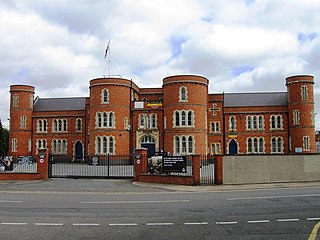The Officers' Training Corps (OTC), more fully called the University Officers' Training Corps (UOTC), are military leadership training units operated by the British Army. Their focus is to develop the leadership abilities of their members whilst giving them an opportunity to take part in military life whilst at university. OTCs also organise non-military outdoor pursuits such as hill walking and mountaineering. UOTC units are not deployable units nor are their cadets classed as trained soldiers until completion of MOD 1 training. The majority of members of the UOTC do not go on to serve in the regular or reserve forces.
The London Regiment was an infantry regiment in the British Army, part of the Territorial Force. The regiment saw service in the First World War and was disbanded in 1938, shortly before the Second World War, when most of its battalions were converted to other roles or transferred elsewhere, and reformed in 1993. The London Guards date their formation to that of this regiment in 1908.

The Post Office Rifles was a unit of the British Army formed in 1868 from volunteers as part of the Volunteer Force, which later became the Territorial Force. The unit evolved several times until 1935, after which the name was lost during one of many reorganisations.

The 47th Division was an infantry division of the British Army, raised in 1908 as part of the Territorial Force.

Colchester Garrison is a major garrison located in Colchester in the county of Essex, eastern England. It has been an important military base since the Roman era. The first permanent military garrison in Colchester was established by Legio XX Valeria Victrix in AD 43, following the Roman conquest of Britain. Colchester was an important garrison town during the Napoleonic Wars and throughout the Victorian era. During the First World War, several battalions of Kitchener's Army were trained there.

The Westmorland and Cumberland Yeomanry was a Yeomanry Cavalry regiment of the British Army with its origins in 1798. The regiment provided troops for the Imperial Yeomanry during the Second Boer War and served on the Western Front in the First World War, latterly as infantry. The regiment converted to artillery in 1920 and served as such in the early years of the Second World War, before becoming part of the Chindits in Burma. Postwar it served as a gunner regiment until 1971 when the title disappeared.
The Surrey Yeomanry was a unit of the British Army first formed as volunteer cavalry in 1794. It was reformed in 1901 and saw varied service in the First World War. During the interwar period, it converted to artillery and during the Second World War one of its regiments distinguished itself during the retreat to Dunkirk, saw action during the Second Battle of El Alamein, and also saw service in Sicily and Italy. Its other regiment served in East Africa, the Siege of Tobruk, and in Iraq and Persia. The regiment's lineage is maintained today by 2 Field Troop, 579 Field Squadron (EOD), part of 101 (London) Engineer Regiment (Volunteers).
The Northern Army Group (NORTHAG) was a NATO military formation comprising five Army Corps from five NATO member nations. During the Cold War NORTHAG was NATO's forward defence in the Northern half of the Federal Republic of Germany (FRG). The Southern half of the Federal Republic of Germany was to be defended by the four Army Corps of NATO's Central Army Group (CENTAG). During wartime NORTHAG would command four frontline corps and one reserve corps. Air support was provided by Second Allied Tactical Air Force.
The 1915 Birthday Honours were appointments by King George V to various orders and honours to reward and highlight good works by citizens of the British Empire. The appointments were made to celebrate the official birthday of The King, and were published in The London Gazette and in The Times on 3 June 1915.

The page contains the current structure of the British Army. The British Army is currently being reorganised to the Future Soldier structure.

The Farringdon Road drill hall is a former military installation at 57A Farringdon Road in Finsbury, London.

The Iverna Gardens drill hall is a military installation in Kensington, London.

Mitcham Road Barracks is an Army Reserve centre in Croydon, London, with a history dating back to 1794.

The Clare Street drill hall is a military installation in Northampton, Northamptonshire. It is a Grade II listed building.
The 24th Battalion, London Regiment was an auxiliary unit of the British Army. Formed in 1908 from Volunteer units in the Surrey suburbs of London that dated back to 1860, it was part of the London Regiment in the Territorial Force (TF). Its battalions served on the Western Front at Salonika and in Palestine during World War I. When the London Regiment was abolished the unit reverted to the Queen's Royal Regiment and served in the Battle of France, in North Africa, including the Battle of Alamein, and in taly and North West Europe as part of the 7th Armoured Division. Postwar it was converted to an anti-aircraft regiment of the Royal Artillery.

The Exeter & South Devon Volunteers was the premier unit of Britain's Volunteer Force. Formed in 1852 it went on to become a battalion of the Devonshire Regiment. Both its active service battalions went to garrison India on the outbreak of the First World War, and then saw action in Mesopotamia and Palestine. In the Second World War, the battalion served in the garrison of Gibraltar. It continued in the postwar Territorial Army until it was merged with other West Country units. Its successors today serve in a reserve battalion of The Rifles.
256 Multi-Role Medical Regiment is a unit of the Royal Army Medical Corps within the Army Reserve of the British Army.











